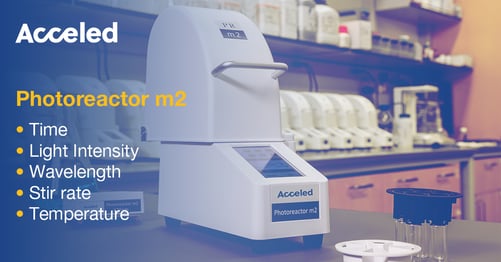In the world of drug discovery, the quest for efficient methods to manipulate small molecules is unending. The emergence of photocatalysis, an innovative approach harnessing the energy of UV and visible light to drive chemical reactions, has revolutionized the field. This article delves into the profound impact of photocatalysis on drug discovery, exploring its applications in peptide functionalization, protein bioconjugation, Csp3-Csp2 cross-coupling, late-stage functionalization, and target identification.
The Power of Photocatalysis in Drug Discovery
Photocatalysis exploits the unique ability of certain catalysts to absorb low-energy UV and visible light, initiating single-electron transfer or energy transfer processes with organic substrates. This capability gives rise to highly reactive intermediates, such as radicals, which can drive diverse chemical transformations.
Unlike traditional methods reliant on stoichiometric reagents, photocatalysis operates under mild conditions, rendering it compatible with aqueous environments and biomolecules. These features make photocatalysis a promising technology in drug discovery, offering benefits like broad functional group tolerance, biocompatibility, site-specific selectivity, and operational simplicity.
Peptide Functionalization and Protein Bioconjugation
Peptides are pivotal in drug discovery, serving as potential drug candidates and building blocks for larger bioactive molecules. Nonetheless, their functionalization and modification can be daunting.
Photocatalysis has emerged as a powerful tool for peptide functionalization and protein bioconjugation, providing a mild and selective approach. Leveraging visible light photocatalysis, researchers have achieved site-specific modifications of peptides and proteins, targeting specific residues like cysteine, tyrosine, methionine, tryptophan, and histidine.
This approach has paved the way for robust transformations, such as tyrosine-specific protein modification, decarboxylative macrocyclization of peptides, chemoselective peptide modifications, and site-selective bioconjugation of native proteins.
Csp3-Csp2 Cross-Coupling via Photocatalysis
Cross-coupling reactions are indispensable in organic synthesis for constructing complex molecules. Traditionally, these reactions relied on organometallic reagents. However, photocatalysis unlocks new possibilities, particularly in coupling sp3 and sp2 carbon atoms.
By amalgamating photocatalysis with nickel catalysis, researchers have achieved direct decarboxylative coupling of carboxylic acids with aryl halides and coupling of potassium trifluoroborates with aryl bromides.
These photocatalytic cross-coupling reactions offer a broad scope, high selectivity, and compatibility with various functional groups, providing a potent tool for synthesizing complex molecules in drug discovery.
 The Photoreactor m2 is back in stock and ready to be shipped!
The Photoreactor m2 is back in stock and ready to be shipped!
Have a light-intense research application? Streamline your photoredox catalysis reactions with the m2.
Late-Stage Functionalization of Pharmaceutically Relevant Compounds
Late-stage functionalization of pharmaceutically relevant compounds is a pivotal strategy in drug discovery, enabling the modification of bioactive molecules to enhance their efficacy and properties.
Photocatalysis has proven invaluable for late-stage functionalization, offering a mild and efficient approach. By harnessing the power of visible light, researchers have achieved direct functionalization of aryl C-H bonds, introducing diverse structural and physicochemical properties to bioactive molecules.
This approach has been particularly instrumental in synthesizing trifluoromethyl and difluoromethyl compounds, known for their tunable properties. Furthermore, photocatalytic late-stage functionalization has facilitated the synthesis of bioisosteres, structural motifs mimicking functional groups that improve drug-like properties.
Target Identification Accelerated by Photocatalysis
Target identification, the process of identifying cellular targets for therapeutic purposes, is a critical step in drug discovery. Traditional approaches like photoaffinity labeling can be costly and time-consuming, especially when dealing with low-abundance membrane proteins or multiple protein target engagement.
Photocatalysis introduces a novel platform for small molecule target identification, utilizing visible light-mediated Dexter energy transfer to generate high-energy carbene intermediates. By disconnecting the reactive warhead from the drug, photocatalytic target identification enables catalytic signal amplification, resulting in multiple labeling events per drug and unprecedented levels of target enrichment.
This methodology has led to the quantitative identification of targets and off-target interactions for several drugs, including (+)-JQ1, paclitaxel, and dasatinib. Moreover, photocatalytic target identification has successfully uncovered the targets of two GPCRs – ADORA2A and GPR40 – a class of drug targets often challenging to identify using traditional methods.
Photocatalysis has emerged as a powerful tool in drug discovery, ushering in new and efficient methods for small molecule reactions. By harnessing the energy of UV and visible light, photocatalysis offers unique advantages in terms of selectivity, compatibility, and operational simplicity. It has revolutionized various aspects of drug discovery, including peptide functionalization, protein bioconjugation, Csp3-Csp2 cross-coupling, late-stage functionalization, and target identification.
As researchers continue to explore the potential of photocatalysis, it is poised to play an increasingly crucial role in the development of novel therapeutics and the optimization of existing drug candidates.
Frequently Asked Questions
- What is photocatalysis in drug discovery?
Photocatalysis is an innovative approach that uses UV and visible light to drive chemical reactions, offering benefits such as site-specific selectivity and compatibility with biomolecules in drug discovery.
- How does photocatalysis impact peptide functionalization and protein bioconjugation?
Photocatalysis enables site-specific modifications of peptides and proteins, making it a powerful tool for achieving selective functionalization.
- What are the advantages of Csp3-Csp2 cross-coupling via photocatalysis?
Photocatalytic cross-coupling reactions offer a broad scope, high selectivity, and compatibility with various functional groups, facilitating the synthesis of complex molecules in drug discovery.
- How does photocatalysis contribute to late-stage functionalization of pharmaceutical compounds?
Photocatalysis allows for the direct functionalization of aryl C-H bonds, enhancing the properties of pharmaceutically relevant compounds.
- What role does photocatalysis play in target identification in drug discovery?
Photocatalytic target identification accelerates the process by utilizing visible light-mediated energy transfer, enabling the quantitative identification of drug targets and off-target interactions.
Are you a Photoreactor m1 or m2 owner? You're due for an upgrade. Capable of 3x the original light intensity, the new 450Hi Light Module will further streamline your photocatalysis reactions:



